Abstract
The chemotactic factor inactivator (CFI) isolated from human serum contains a kininase activity that causes extensive hydrolysis of bradykinin. The highly chemotactic synthetic peptide Met-Leu-Phe was completely hydrolyzed by CFI preparations. The release of the constituent amino acids from this peptide coincided with a loss of its chemotactic activity. The N-formyl, but not the amide derivative, of the leukotactic peptide Met-Leu-Phe was resistant to the action of CFI, as evidenced by chemotactic and biochemical assays. Examination of the specificity of CFI proteolysis revealed that short polypeptide substrates are degraded sequentially from the amino terminus. Larger peptides are less extensively hydrolyzed, and the patterns of hydrolysis are more complex. Inactivation of the bacterial chemotactic factors by CFI was overcome by the addition of high concentrations of peptides which were substrated for CFI. CFI preparations readily hydrolyzed the peptide Arg-Phe-Ala. The constituent amino acids were conveniently identified by thin-layer chromatography method. This procedure afforded a rapid assay for measuring CFI activity in the whole human serum as well as in fractions throughout the purification steps. Moreover, CFI also hydrolyzed L-leucyl-beta-napthylamide at rates comparable to peptides. Thus, L-leucyl-beta-napthylamide served as a useful substrate for estimating CFI activity in preparations at various stages of purification. This substrate was also useful in kinetic studies. The results from these studies indicate an aminopeptidase activity is the mechanism whereby CFI inhibits the activity of chemotactic substrates.
Full text
PDF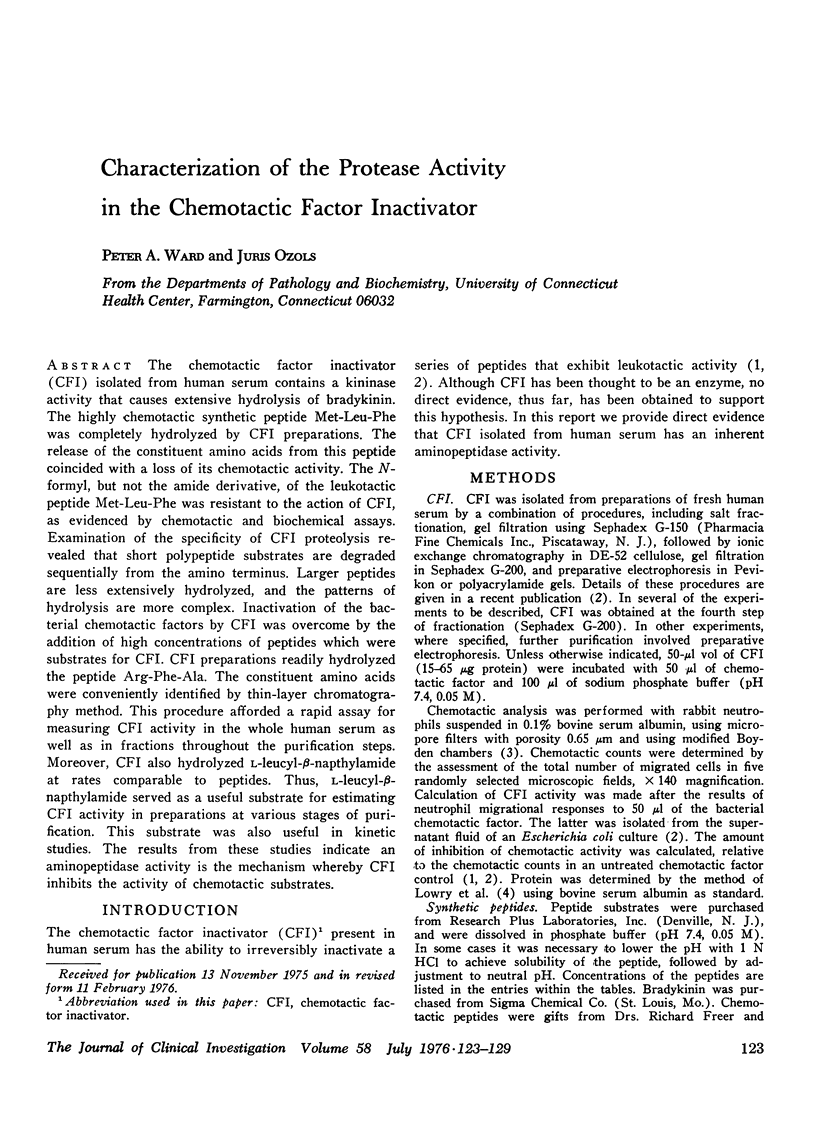
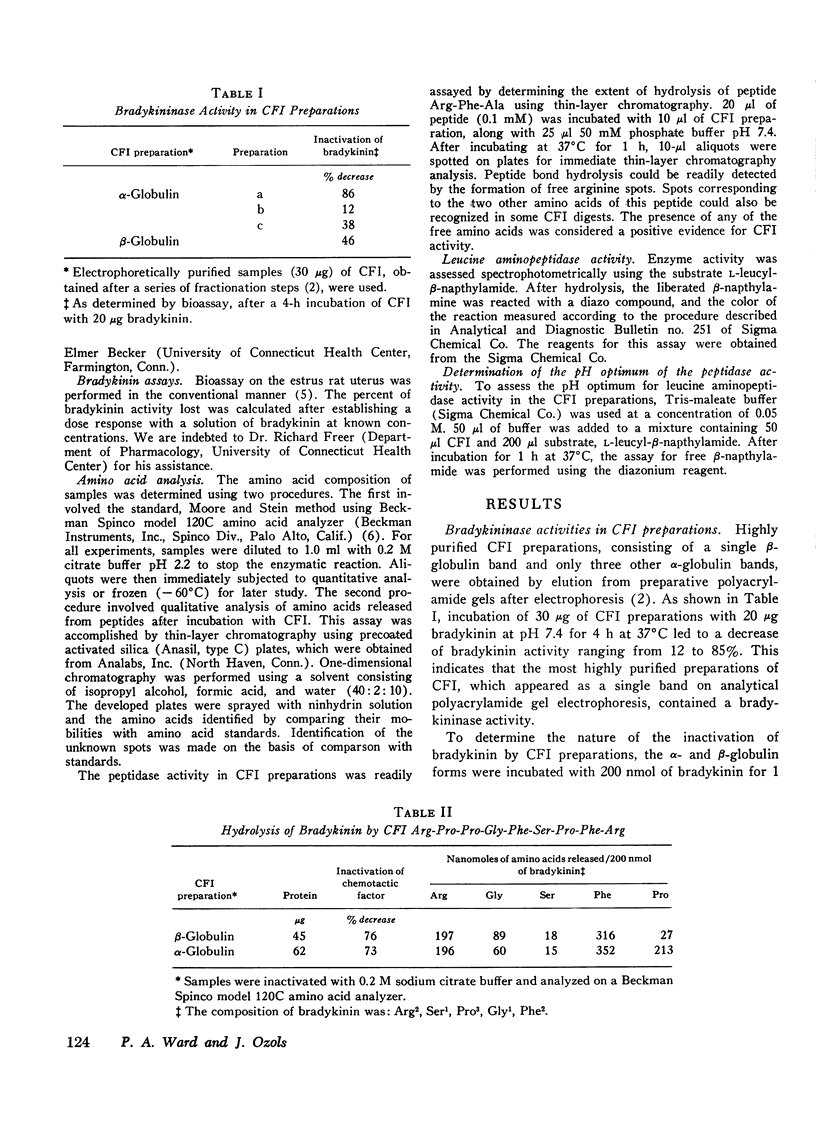
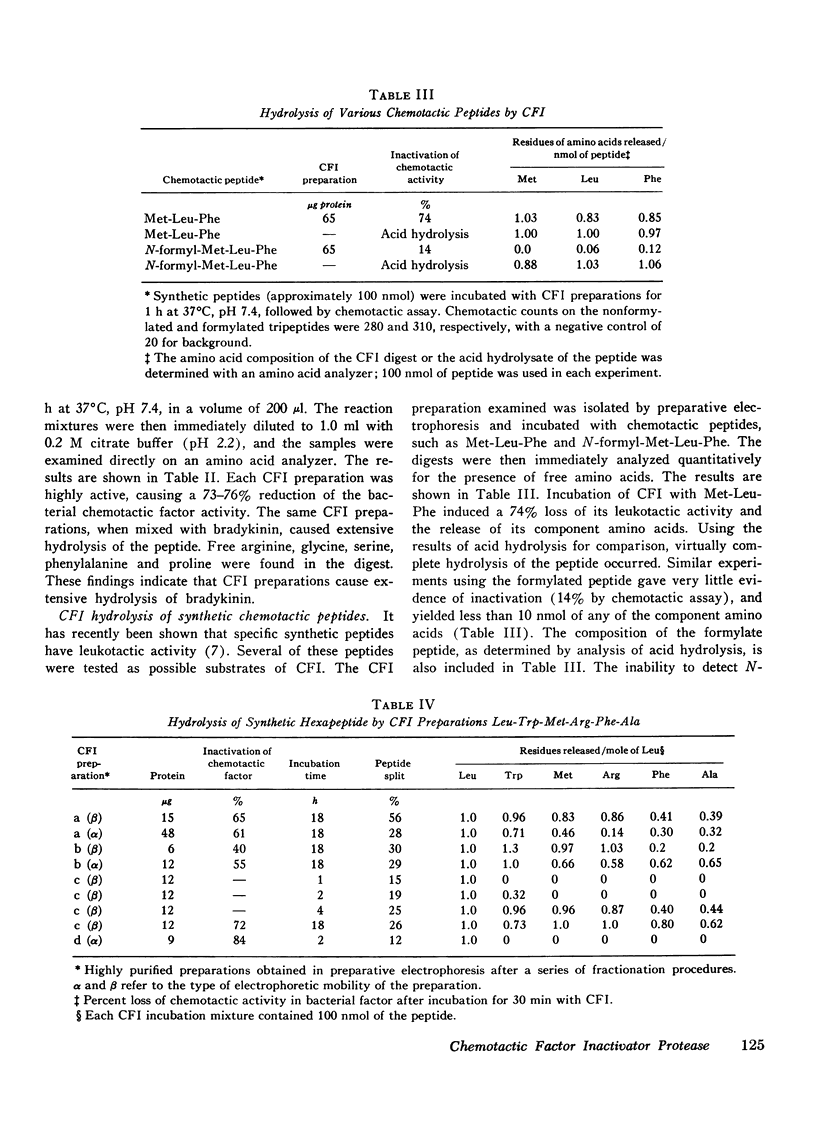

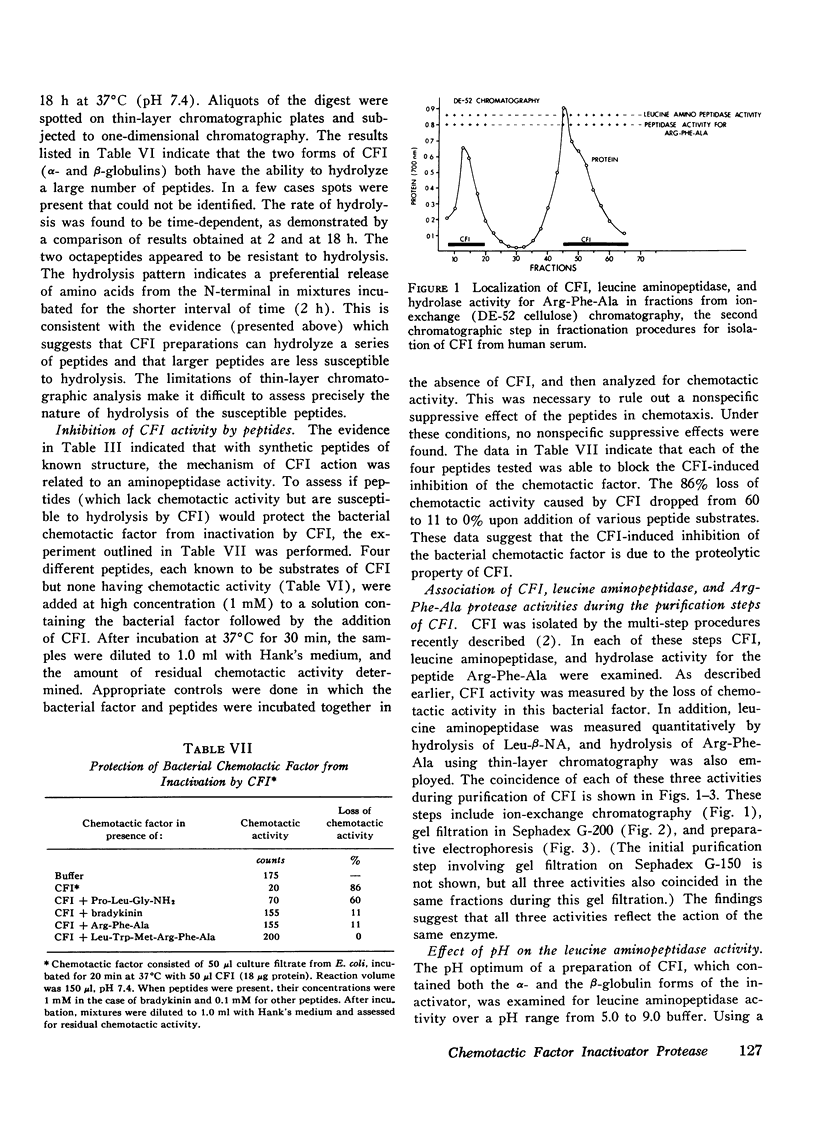
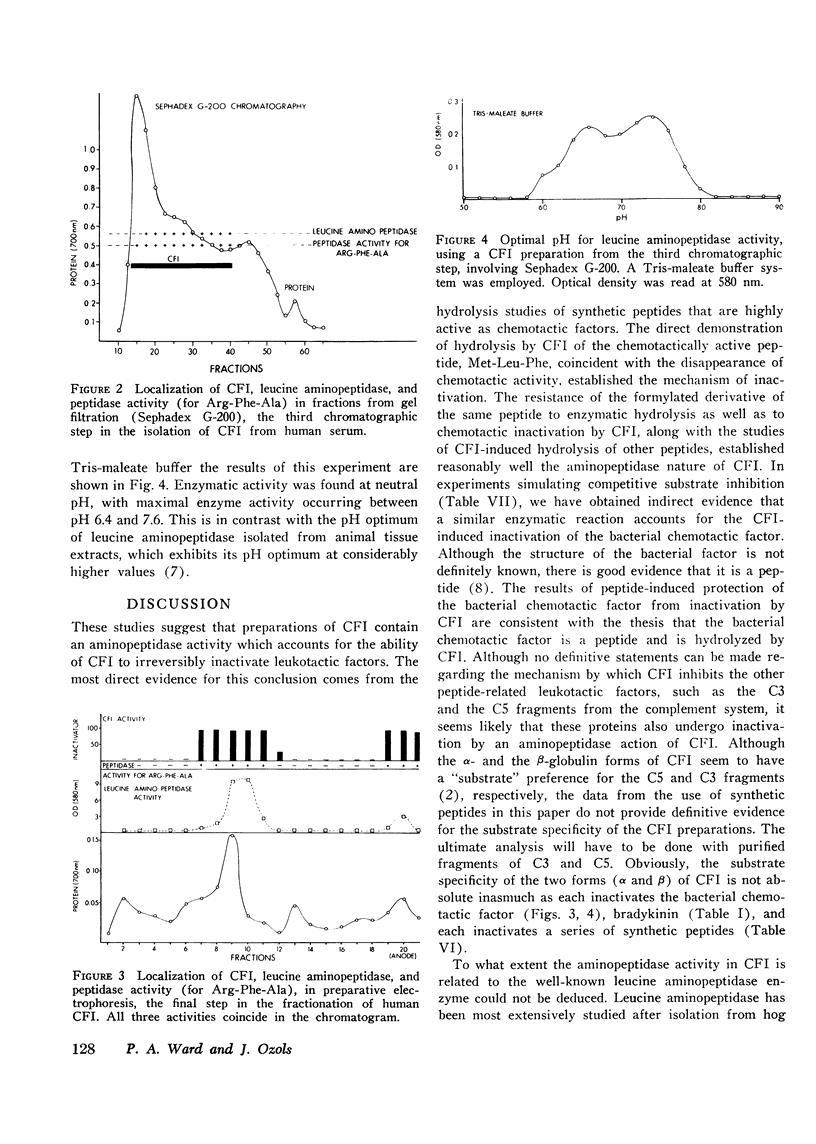
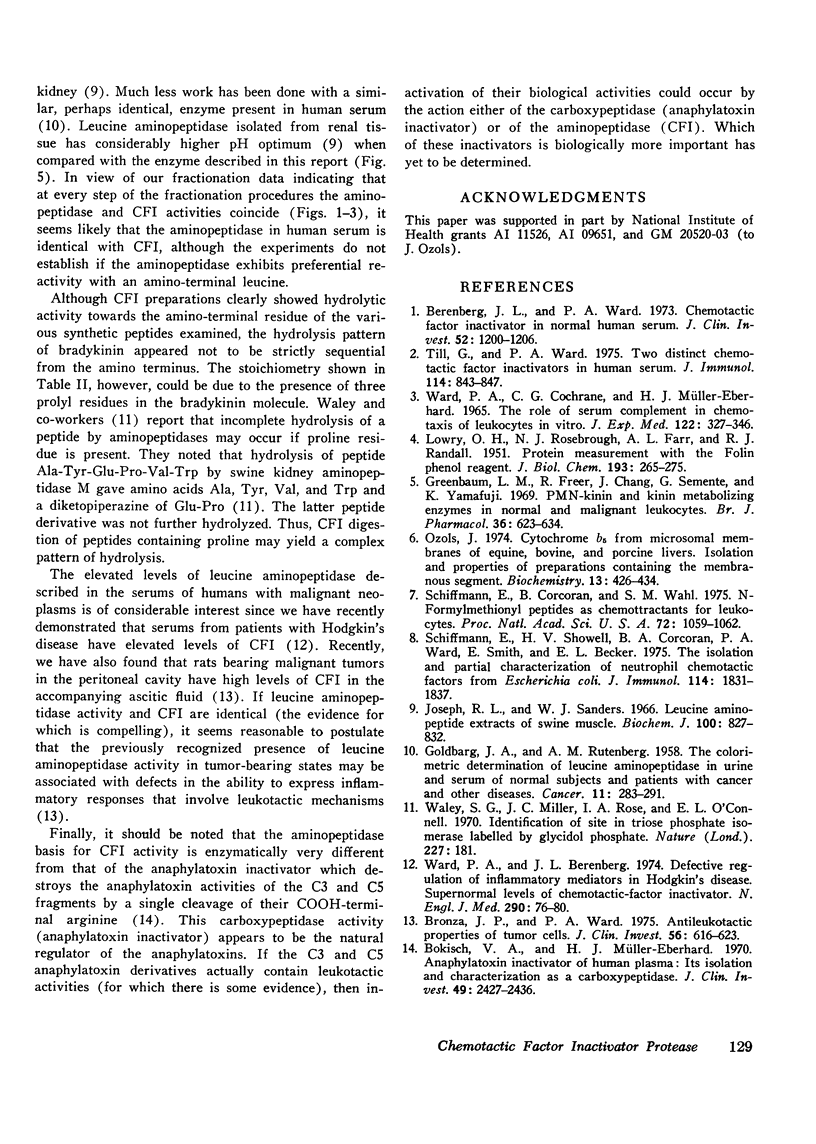
Selected References
These references are in PubMed. This may not be the complete list of references from this article.
- Berenberg J. L., Ward P. A. Chemotactic factor inactivator in normal human serum. J Clin Invest. 1973 May;52(5):1200–1206. doi: 10.1172/JCI107287. [DOI] [PMC free article] [PubMed] [Google Scholar]
- Bokisch V. A., Müller-Eberhard H. J. Anaphylatoxin inactivator of human plasma: its isolation and characterization as a carboxypeptidase. J Clin Invest. 1970 Dec;49(12):2427–2436. doi: 10.1172/JCI106462. [DOI] [PMC free article] [PubMed] [Google Scholar]
- Brozna J. P., Ward P. A. Antileukotactic properties of tumor cells. J Clin Invest. 1975 Sep;56(3):616–623. doi: 10.1172/JCI108131. [DOI] [PMC free article] [PubMed] [Google Scholar]
- GOLDBARG J. A., RUTENBURG A. M. The colorimetric determination of leucine aminopeptidase in urine and serum of normal subjects and patients with cancer and other diseases. Cancer. 1958 Mar-Apr;11(2):283–291. doi: 10.1002/1097-0142(195803/04)11:2<283::aid-cncr2820110209>3.0.co;2-8. [DOI] [PubMed] [Google Scholar]
- Greenbaum L. M., Freer R., Chang J., Semente G., Yamafuji K. PMN-kinin and kinin metabolizing enzymes in normal and malignant leucocytes. Br J Pharmacol. 1969 Jul;36(3):623–634. doi: 10.1111/j.1476-5381.1969.tb08017.x. [DOI] [PMC free article] [PubMed] [Google Scholar]
- Joseph R. L., Sanders W. J. Leucine aminopeptidase in extracts of swine muscle. Biochem J. 1966 Sep;100(3):827–832. doi: 10.1042/bj1000827. [DOI] [PMC free article] [PubMed] [Google Scholar]
- LOWRY O. H., ROSEBROUGH N. J., FARR A. L., RANDALL R. J. Protein measurement with the Folin phenol reagent. J Biol Chem. 1951 Nov;193(1):265–275. [PubMed] [Google Scholar]
- Ozols J. Cytochrome b5 from microsomal membranes of equine, bovine, and porcine livers. Isolation and properties of preparations containing the membranous segment. Biochemistry. 1974 Jan 29;13(3):426–434. doi: 10.1021/bi00700a005. [DOI] [PubMed] [Google Scholar]
- Schiffmann E., Corcoran B. A., Wahl S. M. N-formylmethionyl peptides as chemoattractants for leucocytes. Proc Natl Acad Sci U S A. 1975 Mar;72(3):1059–1062. doi: 10.1073/pnas.72.3.1059. [DOI] [PMC free article] [PubMed] [Google Scholar]
- Schiffmann E., Showell H. V., Corcoran B. A., Ward P. A., Smith E., Becker E. L. The isolation and partial characterization of neutrophil chemotactic factors from Escherichia coli. J Immunol. 1975 Jun;114(6):1831–1837. [PubMed] [Google Scholar]
- Till G., Ward P. A. Two distinct chemotactic factor inactivators in human serum. J Immunol. 1975 Feb;114(2 Pt 2):843–847. [PubMed] [Google Scholar]
- WARD P. A., COCHRANE C. G., MUELLER-EBERHARD H. J. THE ROLE OF SERUM COMPLEMENT IN CHEMOTAXIS OF LEUKOCYTES IN VITRO. J Exp Med. 1965 Aug 1;122:327–346. doi: 10.1084/jem.122.2.327. [DOI] [PMC free article] [PubMed] [Google Scholar]
- Waley S. G., Miller J. C., Rose I. A., O'Connell E. L. Identification of site in triose phosphate isomerase labelled by glycidol phosphate. Nature. 1970 Jul 11;227(5254):181–181. doi: 10.1038/227181a0. [DOI] [PubMed] [Google Scholar]
- Ward P. A., Berenberg J. L. Defective regulation of inflammatory mediators in Hodgkin's disease. Supernormal levels of chemotactic-factor inactivator. N Engl J Med. 1974 Jan 10;290(2):76–80. doi: 10.1056/NEJM197401102900203. [DOI] [PubMed] [Google Scholar]


